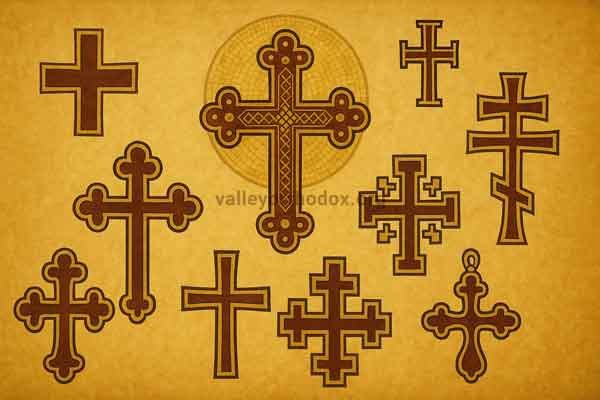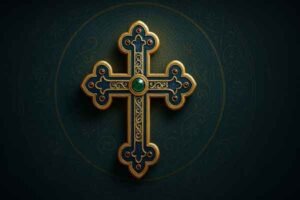Across the Orthodox and wider Eastern Christian world, the cross is more than a shape—it is a confession of faith carried in liturgy, worn in daily life, and traced over homes and fields. This guide surveys the main types of Eastern Christian crosses, what they mean, and how they are used in worship and devotion.
What Makes a Cross “Eastern”? A Quick Overview
Shared faith, distinct forms across Eastern traditions
Eastern crosses share the same core confession—Christ crucified and risen—while displaying regional forms shaped by language, liturgy, and craft. Many designs retain equal-armed balance, budded (trefoil) ends, and inscriptions drawn from Scripture and hymnography.
From altar to necklace: liturgical and personal uses
You’ll meet crosses as altar and processional signs, blessing crosses in the priest’s hand, pectoral crosses worn by clergy, enkolpia (reliquary pectorals), and personal necklaces worn by the faithful—often blessed and tied to baptismal identity.
Forms & Variations (Visual Guide)
Greek Cross (equal-armed)
An early and widespread form with four equal arms, used in church decoration, processional crosses, and personal devotion. Its symmetry evokes the Gospel going to the four corners of the world and the balance of divine order.
Byzantine / Budded (Trefoil) Cross
Arms ending in three rounded buds symbolize the Holy Trinity and the “Tree of Life.” The Byzantine (budded/trefoil) cross often appears on processional and pectoral crosses, sometimes jeweled (crux gemmata) or enameled.
Patriarchal Cross (Double-bar)
Features a shorter upper bar above the main beam, recalling the titulus (“Jesus of Nazareth, King of the Jews”). In Eastern usage it appears in heraldry, processional crosses, and episcopal insignia, underscoring Christ’s kingship proclaimed on the cross.
Russian Orthodox Cross (Three-bar with slanted footrest)
Adds a small upper bar (titulus) and a slanted lower bar (the footrest, or suppedaneum). The lower beam is often shown tilting upward toward the Good Thief (salvation) and downward away from the impenitent thief (judgment), a visual catechism of mercy and justice.
Cross Potent / Jerusalem Cross (Eastern contexts)
Composed of a central cross potent with four smaller crosses. While widely associated with medieval Jerusalem, it appears in Eastern iconography and church decoration to signify mission radiating from the Holy City.
Reliquary Cross (Enkolpion)
A hollow pectoral that opens to hold a relic or a small scriptural text. Worn by clergy and monastics, enkolpia unite personal devotion with the Church’s veneration of holy things.
Blessing, Processional, and Altar Crosses
- Blessing cross: held by the priest for blessings; often ornate, sized for the hand.
- Processional cross: mounted on a staff; leads liturgies and feasts.
- Altar cross: stands on or behind the holy table; focal point of the sanctuary.
Symbolism & Theology
Tree of Life, Victory, and Light
Eastern hymnography calls the cross the “Tree of Life,” a sign of victory over death and a source of light. Jewels, gold, and enamel embody this theology visually: the instrument of death is transfigured into a sign of glory.
Titulus and the slanted footrest
Additional bars catechize: the short upper bar recalls the INRI titulus; the slanted footrest preaches judgment and mercy, directing the eye to Christ’s triumph even in suffering.
Budded ends (trefoils) and Trinitarian meaning
Trefoil terminals compress doctrine into design—Father, Son, and Holy Spirit—while buds suggest new life springing from the cross.
Inscriptions: IC XC NIKA and doxologies
Common inscriptions include IC XC NIKA (“Jesus Christ conquers”), short prayer formulas, and Scripture—brief words that turn the cross into a miniature confession of faith.
Craft & Materials
Metalwork: filigree, granulation, gem setting
Traditional workshops (imperial and monastic) refined filigree (wire patterns), granulation (gold beadwork), and precise gem settings. Even modest pieces echo this heritage with careful lines, engraved borders, and small stones.
Cloisonné enamel and court/monastic ateliers
Cloisonné partitions filled with colored glass paste produce the jewel-like surfaces beloved in Byzantine art. Enamel medallions (Christ, Theotokos, saints) often adorn pectorals and altar crosses.
Wood, stone, and mixed-media traditions
Carved wooden blessing crosses, stone processional markers, and mixed-media crosses (metal over wood) demonstrate the adaptability of the symbol across places and budgets—always at the service of worship.
Regional Styles & Legacy
Byzantine ateliers and Mediterranean spread
Constantinople’s models—balanced proportions, trefoil ends, concise inscriptions—spread through diplomacy, trade, and pilgrimage, shaping church art from the Aegean to Italy and the Levant.
Slavic adaptations and inscriptions
In Slavic lands, sturdier proportions and the three-bar cross gained prominence, with inscriptions rendered in Greek and Church Slavonic; processional and roadside crosses became powerful public witnesses.
Coptic and Ethiopian lattice crosses
Coptic and Ethiopian traditions favor intricate open-work (lattice) designs—hand-crosses and processional crosses whose interlaced patterns symbolize eternity and unbroken communion.
Georgian Grapevine Cross (St. Nino)
The Grapevine Cross, associated with St. Nino, bears gently drooping arms bound with a cord—an image of evangelization and grace spreading like branches.
Armenian stone crosses (khachkars)
In Armenian tradition, stone-carved crosses—khachkars—translate the same theology into monumental relief, with a central cross woven in vines, rosettes, and fruit—the “Tree of Life”—a hallmark of the Armenian Cross (khachkar).
FAQs (Quick Answers)
Why does the Orthodox cross have a slanted bar?
The slanted footrest (suppedaneum) points up toward the Good Thief (paradise) and down away from the unrepentant thief—an icon in miniature of judgment and mercy.
How is the patriarchal (double-bar) cross used?
The upper bar recalls the titulus over Christ’s head; the form appears in heraldry, episcopal insignia, and processional contexts to proclaim Christ’s kingship.
What is an enkolpion reliquary cross?
A hollow pectoral that opens to hold a relic or text, worn chiefly by clergy and monastics as a sign of personal devotion within the Church’s sacramental life.
What does “IC XC NIKA” mean?
“Jesus Christ conquers”—a concise confession that the cross is the sign of victory over sin and death.

